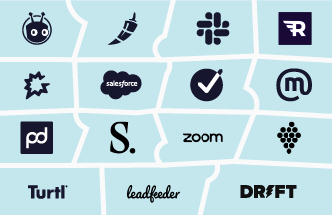12 of the Best Sales Tactics to Close More Deals in 2025
Sales tactics on this page:
It’s time to kick outdated sales tactics to the curb!
So, if you’re still pressure-selling leads and sending out impersonal, cold emails en masse, it’s time to update your sales repertoire.
To help you get started, we’re sharing the best sales tactics for closing more deals and examples to demonstrate them in practice.
Here are some of the most effective sales tactics B2B brands use to crush quota and improve pipeline.
1. Build a personal brand on LinkedIn
Building a personal brand on LinkedIn isn’t only for executives, founders, and influencers.
If you’re an Account Executive, SDR or even part of the marketing team, establishing yourself as an expert in topics relevant to your products or services will help you meet decision-makers in your industry.
By publishing consistently, you’ll develop a following of potential customers interested in the value you share. And these ideal leads will look to you, and eventually your product or service, as the go-to solution.
To speed up your growth rate, you must interact with followers.
How?
Reply to comments and messages or comment on their posts.
Check out this link on social selling for more on this topic!
Example of building a personal brand on LinkedIn
Cognism CMO Alice de Courcy is an excellent example of this sales tactic.
Not only does she post regularly on demand generation marketing, but she’s also turned all her LinkedIn posts into a book to help other CMOs.
The book in question has helped spark rewarding LinkedIn marketing and ABM campaigns. It’s also worked as an excellent inbound sales tactic because companies are so impressed that they’ve signed up with Cognism!
Read it for yourself 👇
2. Think of discovery calls as free consultations
It’s incredible what a simple mindset shift can do to the success rate of your discovery calls.
Some sales reps flub this pivotal call by using pushy sales tactics or asking the prospect irrelevant questions.
When you start to think of discovery calls as free consultations, like what you’d receive from a doctor or a lawyer, you start to focus on the core goals of these early calls:
- Learn about the lead’s pains and needs.
- Educate the lead as much as possible.
Sales teams often forget about the second component, but it’s so powerful!
When you give your prospective customers free and helpful information, they’ll trust you as an expert who understands them and what they’re trying to accomplish.
A rep who recommends methods (other than their solution) that the prospect can use today to remedy their issue becomes invaluable.
Once prospects view you this way, they’ll latch onto you. And competitors won’t stand a chance, no matter their price or USP.
To create an aura of expertise on these calls, you have to become an expert in the subject. You must learn about your industry, clients, and best practices.
Just knowing about your product stack won’t cut it.
However, the extra hours of study are worth the results.
An example of this B2B sales tactic
Premium Ghostwriter Nicholas Cole drives this concept home.
Before every consultation call, he tells himself that the prospect has paid him $100 for this call.
This primes him to focus on providing value to the lead:
- To listen closely.
- To ask relevant questions.
- And, most of all, to share what he knows for free.
He teaches potential clients how ghostwriting works and why their current content strategy isn’t working.
This approach has helped him close hundreds of executives, founders, and investors for his ghostwriting service by positioning himself as a thinker, not just a writer.
3. Cold call (the competition is lower than ever)
While competition for attention is rising in email inboxes, it’s decreasing on the airwaves.
The average sales rep is reluctant to prospect using the phone.
Why?
Not because it’s ineffective — we’ve already dealt with the “Is cold calling dead?” question. In our latest Cold Calling Report, after analysing 55,701 dials, we found that cold calls have an average success rate of 4.82%.
Instead, reps are likely avoiding the phones primarily because it’s far more uncomfortable than sending emails or messaging people on LinkedIn.
So, if you have the guts to lean into that discomfort and call decision-makers, you’ll stand out from the competition with this sales tactic.
While SDRs at competing companies are battling it out in the inboxes, you’ll make human connections and get immediate answers.
Of course, to succeed in cold calling, you have to do it right.
That means:
- Research leads before the call.
- Identifying details to warm up the call (a blog post, a recent event, etc.)
- Using a flexible cold calling script.
- Analysing and refining your process.
Don’t assume that C-Suite execs won’t answer the phones.
Our research found that they’re the ones most likely to answer!
Example of an effective cold calling opening
Many reps struggle with opening the cold call, which is the most crucial part.
In his book New Sales Simplified, Mike Weinberg recommends a technique that works well.
It immediately presents you as an authority and problem-solver, raising the chances that your prospective buyer will agree to a meeting.
Here it is (use it after a bit of rapport-building that shows you know them):
“I head up new business at (company name), and in recent months, a lot of (target company type) have been coming to us saying they’re tired of (pain point 1), which is costing them serious (consequence of pain point 1).”
He recommends pausing and waiting for a response.
The hope is that if you got your pain point right, they’ll be suffering from it and let you know. If they aren’t, you mention another relevant one.
If one resonates, you can ask them follow-up questions about the problem, and as soon as you sense their interest, ask for a meeting.
He recommends not hanging up until you’ve asked three times. This is because people instinctively say no. We recommend reading his book for more tips on outbound sales tactics.
4. Start tracking sales triggers
Tracking triggers is a sales tactic to increase revenue. A trigger signals an opportunity to start a sales conversation with potential buyers.
For instance, that might be a company merger, a change in management, or your ideal customer getting promoted.
How to implement this sales tactic
Tracking these events with a sales intelligence tool like Cognism enables sales professionals to reach out at precisely the right time. Better yet, it provides them with a natural way to begin the conversation.
To track these data points manually, you can follow your target accounts on social media and subscribe to their newsletter.
Google Alerts and industry news sites will also provide helpful intel.
5. Ask clients for introductions
Leverage your happy customers to find new clients. Ask them for introductions to ideal customers in their network.
You can find these ideal leads by filtering the client’s contacts on LinkedIn according to the qualities of your ideal customer profile.
Once you’ve found a few people you want to meet, make it easy for the client to make an introduction.
To do this, try two tactics:
- Give them a pre-written email they can send that introduces your brand and states how you can help them.
- Pass on their details so you can reach out, referencing your client.
Doing this sales tactic right is a great way to generate new sales opportunities quickly. And since the lead learns about you from a trusted peer, they’ll be easier to convert.
6. Use cross-team collaboration
A common sales tactic is to use cross-team collaboration. If you’re struggling to close a deal, you can always get help from someone who’s an expert in the aspects of the sale that are giving you trouble.
If the deal is confusing you on a technical level, that might mean asking someone on your product team to review your sales email.
Remember, sales might make you feel siloed, but you’re rarely alone. Whether it’s your manager or someone on the marketing team, your peers want to help.
By tapping into their areas of expertise, you can refine your pitches, answer tough client questions, and win more deals.
Example:
Let’s say your client is asking complicated questions about how a new AI feature works in your software platform, which is still out of your wheelhouse.
When it comes to this type of sales tactic, don’t try to answer it. Message your sales engineer or product expert.
They can then schedule a time to discuss the feature with the client in a non-sales atmosphere. They could also provide them with a white paper or other relevant content.
Then, once the client has gotten their answers and is satisfied, you can focus on closing the deal.
7. Cold email like a copywriter
Cold emailing is a good sales tactic for starting conversations with cold leads.
However, it’s competitive out there.
You will have to bring your A-game regarding relevance, personalisation, and the uniqueness of your offer if you expect a positive reply.
You’ll also need to learn to grab and hold attention like a copywriter.
That means:
- Showing them you know them with a compliment or insight.
- Educating them on something they’re doing wrong.
- Using evidence to prove they have a problem you can fix.
- Painting a clear before-and-after picture of clients just like them.
Do this, and your leads will see you as valuable, not just as someone armed with an email automation tool.
8. Book more group calls
In a study of over 3,000 sales opportunities, Gong found that the more buyer-side attendees in a sales call, the higher the win rate.
And the later in the sales cycle this call occurs, the greater its effectiveness.
The power of these calls often comes down to the following:
Increased impact
You reach more people who can become internal champions.
Peer pressure
If the decision-maker sees the rest of their team enjoying what they’re hearing, they’ll feed off that energy and be more likely to make the purchase.
Try securing more of these group calls by asking your point of contact if any other stakeholders should be on the call or demo.
This is an excellent sales closing tactic, especially if you can specifically name people you want on the call and explain why. Once again, you’re taking work off the plate of the buyer.
Implementing this sales tactic is easy:
A week before the call, recommend including their tech expert and most experienced sales leader, as they will offer unique perspectives on the platform’s use cases.
During the call, be sure to call out a person’s name when listing a use case that relates to their day-to-day rather than always keeping the messaging broad.
Of course, focus most on the one with the most decision-making power, but always pay attention to an attendee.
For all you know, their enthusiasm could be the final nudge the deal needed to reach a close.
For instance, say the head of management was worried specific staff wouldn’t use the solution; once they see the sales leaders’ excitement, they’ll think otherwise.
9. Leverage sales analytics
More and more CRMs are adding AI-based analytics functionality to their software.
This feature enables you to use historical and present sales data to understand your performance better and find improvement opportunities.
For example:
Imagine that after analysing last year’s discovery calls with a conversation intelligence platform like Gong, you discovered that specific questions are associated with higher close rates.
Thanks to that intel, you can now focus on asking those questions more often.
Better yet, this sales success tactic allows you to pinpoint why clients respond so positively to those questions and use those insights to inform the rest of your sales process and tactics.
10. Provide prospects with a steady stream of free value
Once you have a prospect in your pipeline, don’t stop sending them free product knowledge.
Continue sharing educational content relevant to their situation and highlighting your product’s worth.
As long as the content you share helps them achieve their sales goals, they’ll appreciate it and view you as a helpful resource they want to work with.
An example of this sales strategy tactic
Pretend you’re selling LinkedIn growth hacking to a CEO at a top tech company.
They’ve read your samples and said, “We’re going to discuss this and get back to you in a few weeks. Thanks!”
Instead of sitting there like a duck, you could remind them of your value by sending an article on growth hacking in SaaS sales.
If you’re worried this might give away your secrets and compel them to do it independently, don’t be.
They’ll appreciate the gesture, read the article, and see how they can use your tool to achieve their goals.
11. Share more customer success stories
It’s well-known that prospects are more likely to buy from you if you can prove that you’ve delivered the results they want to customers just like them.
If the customer never sees these results, it won’t work.
And that’s a bad sales tactic.
Sales and marketing teams should actively promote content like case studies, testimonials and great reviews across social channels and email. Using them wins trust and gets attention from cold leads.
12. Give the customer a seamless customer journey
Customers want to learn about your solution in the most comfortable way.
So, make your customer journey more service-focused. It’s one of many sales tactics and strategies that increase opportunities and conversations.
For instance, if your potential customers aren’t ready for a call with one of your sales reps, you can direct them to an on-demand demo, as Cognism has created with our demo centre.
At the recording’s end, enter your potential leads into a lead nurture campaign. Encourage them to get in touch when they’re ready to purchase.
This soft sales tactic filters out people who are unlikely to buy the software anyway. It leads to higher-quality live demos.
Great sales tactics need quality data
To implement sales tactics that work, you need quality B2B data.
Cognism gives you all the necessary information to make fewer calls, contact the most relevant people, and hit quota faster.
Book a demo with a data expert to see the platform in action 👇




.jpg)